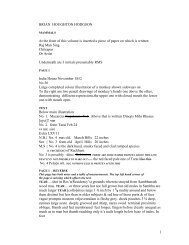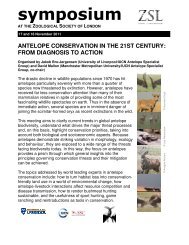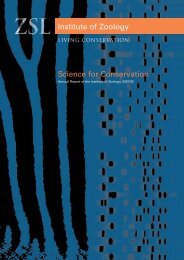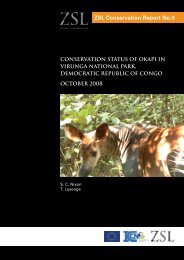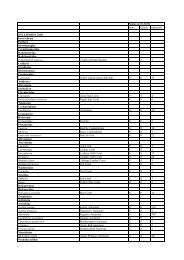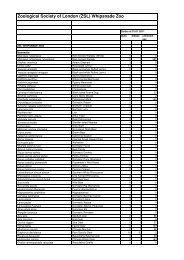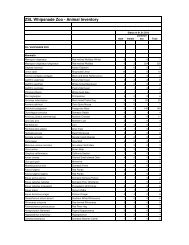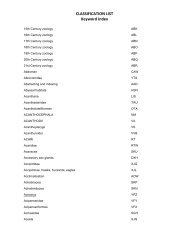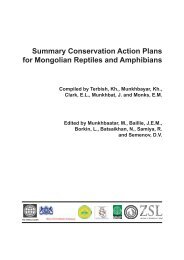MPA Symposium - Zoological Society of London
MPA Symposium - Zoological Society of London
MPA Symposium - Zoological Society of London
Create successful ePaper yourself
Turn your PDF publications into a flip-book with our unique Google optimized e-Paper software.
MARINE PROTECTED AREAS ON THE HIGH SEAS<br />
AN INTERNATIONAL SYMPOSIUM HELD AT ZSL ON 3 AND 4 FEBRUARY 2011<br />
ABSTRACTS OF TALKS<br />
SESSION IV: SOLUTIONS AND THE TRANSLATION OF SCIENCE INTO POLICY<br />
Chair: Kirsty Kemp (Institute <strong>of</strong> Zoology, ZSL)<br />
9.00–9.25 Minimizing fisheries displacement in <strong>of</strong>fshore <strong>MPA</strong> design<br />
Jason M. Hall-Spencer, Mariagrazia Graziano, Emma L. Jackson and Martin J.<br />
Attrill, Marine Institute, University <strong>of</strong> Plymouth, UK<br />
Fisheries closures are rapidly being developed to protect vulnerable marine ecosystems<br />
worldwide. It is possible to create lose-lose situations with the loss <strong>of</strong> good fishing grounds<br />
within fisheries closures causing displacement <strong>of</strong> effort that may increase damage to sensitive<br />
habitat types, create unintended conflicts with other uses <strong>of</strong> the seas or forcing fishermen further<br />
<strong>of</strong>fshore, increasing fuel costs and CO2 emissions. Displacement <strong>of</strong> demersal towed gear is<br />
highly likely if closures are set up in areas that are currently heavily fished with towed demersal<br />
gear and have conservation objectives designed to protect or allow the recovery <strong>of</strong> features that<br />
are vulnerable to the effects <strong>of</strong> demersal towed gear. Win-win situations are also possible;<br />
satellite monitoring <strong>of</strong> fishing vessel activity indicates that <strong>of</strong>fshore closures can work effectively<br />
with good compliance by international fleets even in remote areas. Here we show how remote<br />
fisheries closures have been designed to protect Lophelia pertusa habitat in a region <strong>of</strong> the NE<br />
Atlantic that straddles the EU fishing zone and the high seas. Scientific records, fishers’<br />
knowledge and surveillance data on fishing activity can be combined to provide a powerful tool<br />
for the design <strong>of</strong> Marine Protected Areas that minimises displacement <strong>of</strong> fishing effort.<br />
This work is funded by the EC Framework 7 project Knowledge-based Sustainable Management<br />
for Europe’s Seas (KnowSeas-226675).<br />
9.25–9.50 Understanding deep sea Vulnerable Marine Ecosystems and Fisheries in<br />
the NW Atlantic: links between productivity and biodiversity<br />
Andrew Kenny and Christopher Barrio Frojan, CEFAS, UK<br />
Over-fishing, together with climate change and other human pressures, is producing impacts <strong>of</strong><br />
unprecedented intensity and frequency on both shallow and deep-sea ecosystems, causing<br />
changes in biodiversity, structure and organisation <strong>of</strong> marine assemblages directly and indirectly.<br />
A general relationship exists between marine ecosystem productivity and biodiversity, such that<br />
increased biodiversity is <strong>of</strong>ten associated with enhanced productivity and biomass when<br />
measured at the regional scale, but when assessed at more local scales and in closed systems,<br />
patterns are found to be mainly unimodal. By contrast, analysis <strong>of</strong> certain biotic components <strong>of</strong><br />
deep-sea ecosystems has shown that functioning <strong>of</strong> these ecosystems is not only positively, but<br />
is exponentially related to biodiversity. Such results suggest that higher biodiversity in the deep<br />
sea supports higher rates <strong>of</strong> ecosystem processes and an increased efficiency with which these<br />
processes are performed. These exponential relationships support the hypothesis that mutually<br />
positive functional interactions (ecological facilitation) are much more prevalent in deep-sea<br />
ecosystems compared with coastal and shelf-sea ecosystems, and it seems likely this is<br />
associated (in part) with increased environmental stability and increased habitat structural<br />
complexity. In particular, the importance <strong>of</strong> habitat structural complexity in facilitating increased<br />
benthic productivity in the deep sea has probably been underestimated. This assertion (if<br />
proven) would have significant implications for fisheries management in the deep sea, as it<br />
highlights the importance <strong>of</strong> protecting seabed habitats in order to sustain deep-sea fisheries<br />
production compared to shallow shelf-sea ecosystems.<br />
For further information, please contact: Publications and Meetings, ZSL, Regent’s Park, <strong>London</strong> NW1 4RY, UK. anne.braae@zsl.org



